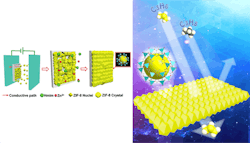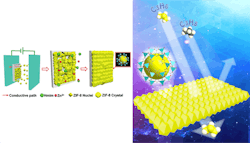Membrane Advance May Transform Gas Separation
Pores in the molecular structure of metal organic frameworks (MOFs) enable impressive gas-separation performance. Indeed, researchers from Australia and Japan have shown that nano-scale membranes made from MOFs can yield orders-of-magnitude improvement over existing techniques. For example, one called ZIF-8 (zeolitic imidazolium frameworks-8) lets propylene diffuse through its pores 125 times more efficiently than propane at 30°C.
However, synthesis of the required highly intergrown ultra thin films without complex porous supports has proven challenging. In addition, a generic crystallization route capable of producing a wide range of MOF structures in the required thin-film morphology is necessary.
“The main challenge with this approach is to synthesize high-quality, ultra thin MOF films on commercial porous substrates without complicated substrate modifications,” explains Kumar Varoon Agrawal, an assistant professor and chair of advanced separations at École Polytechnique Fédérale de Lausanne (EPFL), Sion, Switzerland.
“Such high-quality films have fewer defects and are necessary for obtaining the highest possible separation selectivity,” he stresses.
Figure 1. Electophoretic nuclear assembly transforms MOFs into highly efficient membranes for gas separation. Source: K.V. Agrawal/EPFL.
A technique devised by Agrawal’s team at the Sion lab just might provide the way to make such films.
Known as electrophoretic nuclei assembly for crystallization of highly intergrown thin films (ENACT), their new method allows simple regulation of the heterogeneous nucleation on unmodified porous and nonporous substrates. This, in turn, facilitates the synthesis of ultra thin highly intergrown polycrystalline MOF films.
The team used the ENACT method to synthesize 500-nm-thick MOF membranes. When tested, these membranes provided one of the best performances in propylene/propane separation recorded to date. The ultra thin film also yielded large propylene permeance (flux normalized with pressure difference) that will help reduce the membrane area needed for industrial applications.
“Scale-up of inorganic membranes is indeed one of the biggest challenges. This needs to be carried out on low-cost polymer support, and in a reproducible fashion. Our method allows for both,” notes Agrawal.
“We are naturally interested in improving the process to make even better membranes. Currently, we are optimizing the process to improve the separation selectivity. On [the] scale-up front, we will develop a method to synthesize MOF membranes on a hollow-fiber support,” he says.
The potential for the technology is enormous, Agrawaladds, with many industrially important separations possible — including hydrogen/carbon dioxide, carbon dioxide/methane, carbon dioxide/nitrogen and ethane/propane.
The work already has attracted the interest of a number of undisclosed companies.

